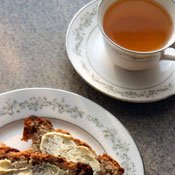Wednesday, January 13, 2010
It may be surprising to learn that one of the more widely consumed beverages on the planetsecond only to watercame about by accident. According to legend, as Chinese Emperor Shen Nung boiled his drinking water over an open fire, a leaf from a nearby plant fell into his cup and turned the water brown.
Intrigued, Shen Nung tasted the strange concoction and found the beverage invigorating, and believed it gave him contentment and determination. Five thousand years after Shen Nung's discovery, the world consumes more than 2.5 million metric tons of tea each year.
Today, we drink virtually the same tea that Shen Nung drank the day he discovered it. Americans alone drink 140 million cups of tea each day, 80 percent in the form of iced tea. Like hot tea, iced tea was an accident. History credits Englishman Richard Blechynden with the invention during a sweltering day at the 1904 World's Fair when he added ice to his hot tea to boost his slumping sales. However, some evidence has shown that southerners knew about this refreshing beverage long before then.
Most tea comes from three countries: a specific growing region that spreads across eastern and southern China; northern Myanmar; and the Assam state of India. All tea leaves are harvested from a plant known as Camellia sinensis. Similar to wine, it comes in many varietals that possess unique characteristics influenced by the region and the processing of the leaves. Harvesters pick only the top two inches of the plant. These buds and leaves are called flushes.
If you were paying attention in your grade-school science class, you will recall that chlorophyll is what gives a leaf its green color. Once a leaf no longer produces chlorophyll, it begins to change color and die. After a tea leaf is picked, it begins to undergo the same process. In the tea industry, this process is known as fermentation.
The techniques used to prevent fermentation create different types of tea. The most common teas on the market are white, green, Oolong and black.
White tea is picked in early spring before the leaf buds have opened. Its name comes from the fine white hair found on the unopened shoots. Once picked, the leaves are allowed to wilt and then air dry. It has a nutty or vegetal flavor.
Once harvested, green tea leaves are immediately heated to prevent wilting and fermentation. The leaves are typically more delicate and should be brewed in water cooler than boiling to prevent cooking the leaves and destroying the flavor, which is grassy and sweet.
Oolong tea is only ferments partiallyto a point between black and green. Heating the leaves interrupts the fermentation process. The leaves are then dried. Oolong tea possesses a floral flavor.
Black tea leaves, the most popular tea in America, dry on special racks to remove excess moisture. Once dry, a tea farmer rolls and twists the leaves by hand to release the leaf's juices. It is then left to ferment and afterward dried in ovens. Black teas are known for their full-bodied flavors.
When brewing that perfect cup, follow a few basic steps. Start with fresh cold water. You may think you are saving time by using hot tap water; however, hot tap water contains less oxygen and can produce a flat flavor. Heat your water according to the type of tea leaf. Brew white or green teas well below boiling, at 170-185 degrees Fahrenheit. Steep Oolong in water that is between 185-210 degrees Fahrenheit. You can steep black tea in water that has just reached boiling.
Pre-warm your teapot by swishing a little hot water around in it. Skipping this step will cause the water temperature to drop once it hits a cold pot.
True tea connoisseurs only brew loose tea leaves. Confining tea to a teabag does not allow the leaves to unfurl and release their entire flavor. Typically, you should use one to two teaspoons per 8-ounce cup.
Just as each tea varietal requires its own water temperature to unlock its flavors, the type also dictates how long you should steep. Steep white tea for 30 seconds to two minutes, green for one to three minutes, Oolong for three to five minutes, and black for three to five minutes.
You can keep properly stored tea for up to one year. Just be sure to keep it away from air, light, heat, moisture and odors as these can alter or destroy a tea's flavor. Also, do not store tea in the refrigerator or freezer, as condensation can ruin the leaves.
After Shen Nung sipped his first cup of tea, he may not have been far off in his conclusions on how tea affects the body and mind. Studies have shown that drinking tea improves mental alertness, increases the body's metabolic rate, lowers stress hormone levels and works as an antidepressant.
Other studies conclude that tea is helpful in the treatment of certain medical conditions such as atherosclerosis, cancer, diabetes prevention and Alzheimer's.

Comments
Use the comment form below to begin a discussion about this content.
Sign in to comment
Or login with:
OpenID